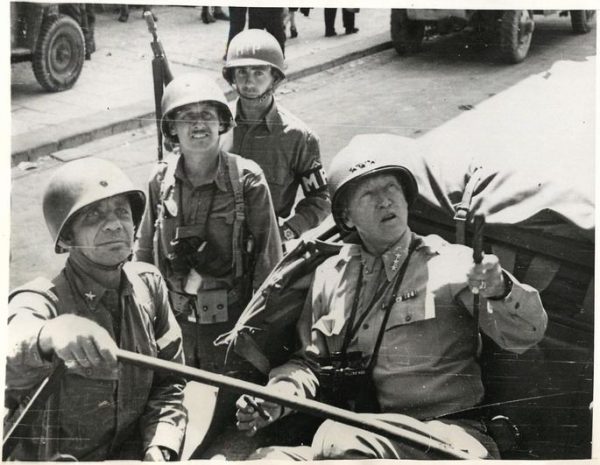World War II Chronicle: July 25, 1943
Click here for TODAY’S NEWSPAPER
Front page: United States bombers are now targeting Norway… You may not have heard of Lt. Cmdr. McClelland Barclay but you’ve seen his work. A week ago the artist was aboard a tank landing ship in the Solomons when it was sunk by a Japanese submarine. His body was lost at sea…
Brig. Gen. Theodore Roosevelt Jr. and Lt. Gen. George Patton are pictured together in Sicily on page two. Roosevelt is currently the 1st Infantry Division’s assistant commander while Patton leads Seventh Army. While Patton has a great deal of respect for Roosevelt, the spit-and-polish general is not fond of Roosevelt’s or 1st Division commanding general Maj. Gen. Terry Allen’s leadership style and will soon request to rotate them out for new commanders…

Speaking of Roosevelts, last week Col. Eliot Roosevelt was pitching the successful strategy of pairing aerial photo reconnaissance with strategic bombing. He continues to do so on page two… Patton had told a British air marshall that his troops would be in the capital of Palermo by midnight on July 23rd and he won the bet (see page three)… In China, Maj. Gen. Claire Chennault is hearing intelligence that the Japanese are running short of pilots and are issuing calls for men to join the air force (page four)… Page five: George Fielding Eliot says the capture of Palermo is the “beginning of the end” for the Axis on Sicily…
Sports on page 21, which highlights Rip Sewell’s “eephus” pitch. Sewell started out with the Detroit Tigers, but after a fight with Hank Greenberg, he camped out in the minors for five years. The 31-year old Sewell finally got called back to the big show in 1938, and he went on to win 15 or more games four times. A shooting injury to his lead foot inspired Rip to come up with a pitch with an incredibly slow pitch and a high trajectory. The only player to ever hit a home run off the eephus was Ted Williams, who did so in the 1946 All-Star game. The 40-50 m.p.h. eephus likely saved a lot of wear and tear on Rip’s arm, allowing him to play until age 49…
Grantland Rice discusses how the Navy is keeping college football afloat with its aviation cadet program (see page 25). Many players that either were playing college ball elsewhere before transferring to a Navy-administered school, had already graduated, or even played pro ball are packing the lineups for pre-flight schools… This week in the war summarized on page 31…
Evening star. (Washington, D.C.), 25 July 1943. Chronicling America: Historic American Newspapers. Lib. of Congress.
https://chroniclingamerica.loc.gov/lccn/sn83045462/1943-07-25/ed-1/
